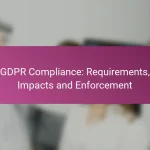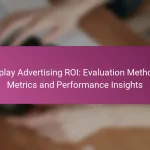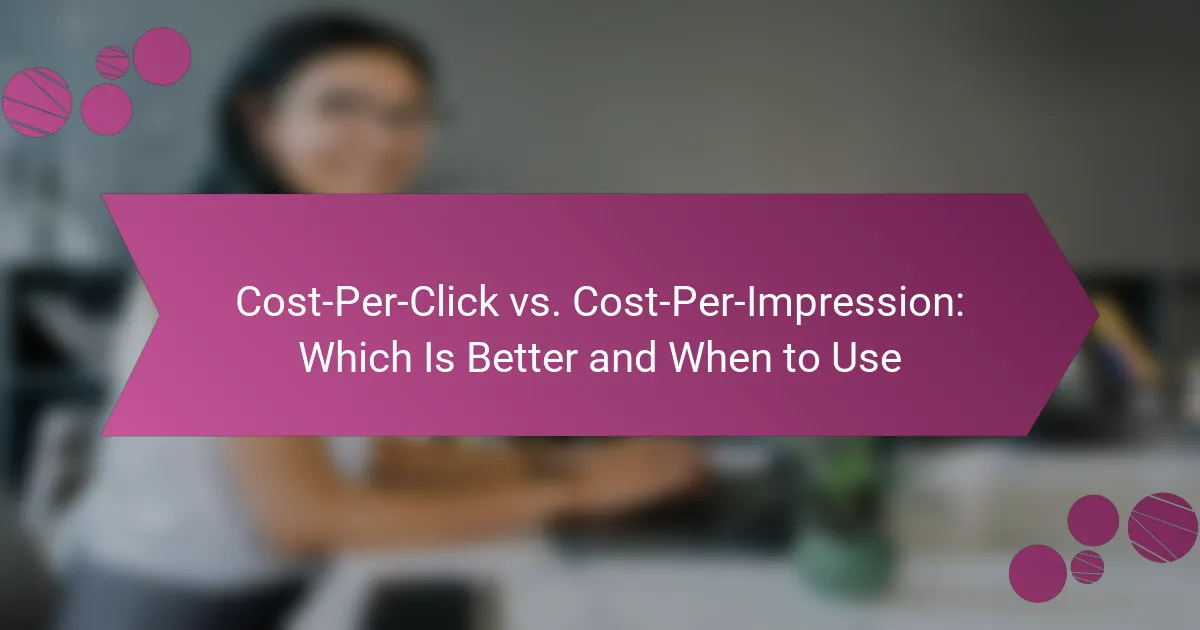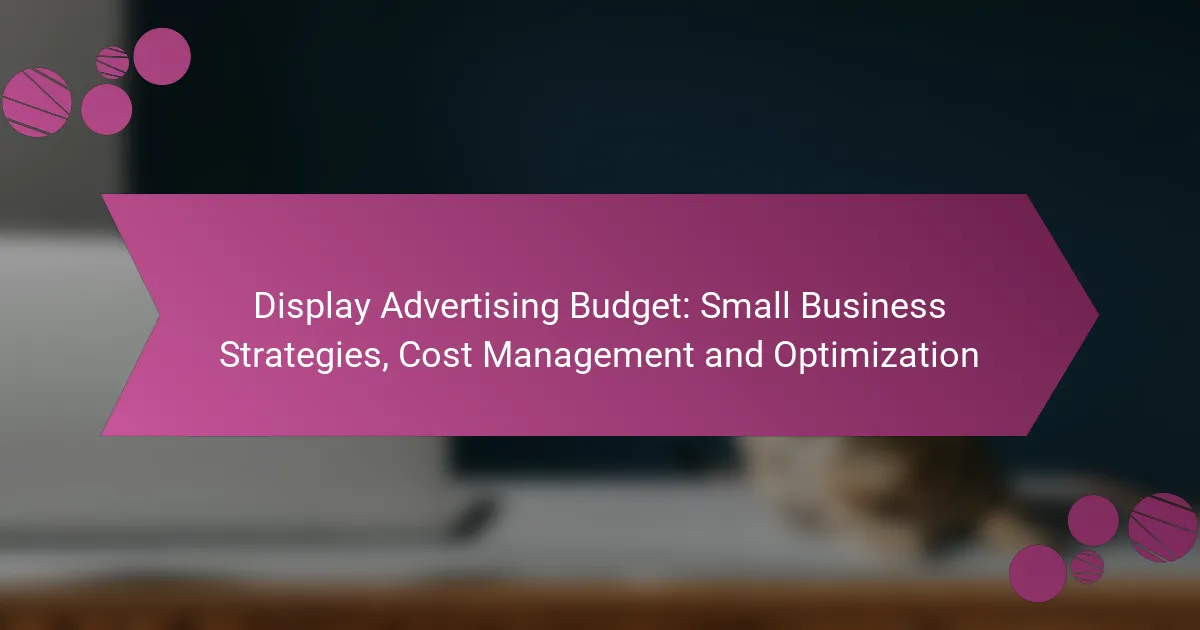Understanding the differences between Cost-Per-Click (CPC) and Cost-Per-Impression (CPM) is crucial for optimizing your advertising strategy. CPC is best suited for campaigns aimed at driving immediate traffic and conversions, while CPM excels in enhancing brand visibility and recognition over time. Choosing the right model depends on your specific campaign goals and target audience.
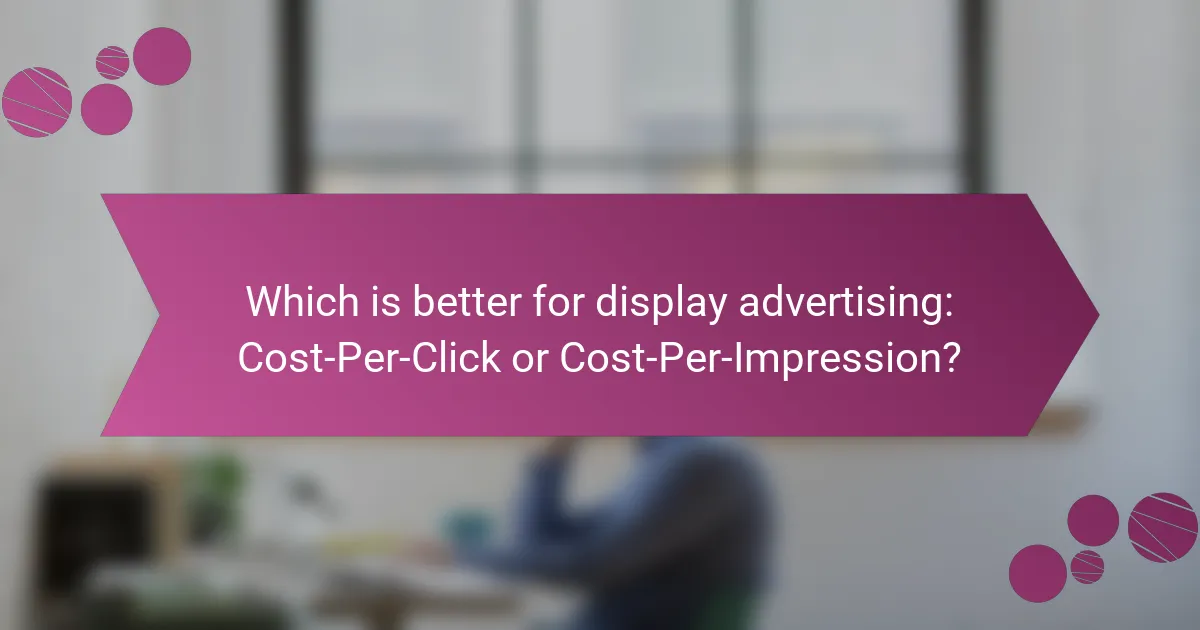
Which is better for display advertising: Cost-Per-Click or Cost-Per-Impression?
The choice between Cost-Per-Click (CPC) and Cost-Per-Impression (CPM) in display advertising depends on your campaign goals. CPC is generally better for driving immediate engagement, while CPM is more effective for building brand visibility over time.
Cost-Per-Click maximizes engagement
Cost-Per-Click (CPC) focuses on driving user actions, such as clicks on ads. Advertisers pay only when a user interacts with their ad, making it a cost-effective option for campaigns aimed at generating leads or sales.
When using CPC, it’s crucial to target the right audience to maximize returns. Consider using tools like Google Ads to refine your targeting based on demographics, interests, and behaviors. This approach can help improve click-through rates (CTR) and overall engagement.
Common pitfalls include neglecting ad quality and relevance. Ensure your ads are compelling and directly related to the landing page to maintain user interest and reduce bounce rates.
Cost-Per-Impression increases brand visibility
Cost-Per-Impression (CPM) is designed for advertisers looking to enhance brand awareness. With CPM, you pay for every thousand impressions your ad receives, regardless of whether users click on it. This model is ideal for campaigns focused on reaching a broad audience.
To effectively use CPM, create visually appealing ads that convey your brand message clearly. High-quality images and concise text can capture attention and improve brand recall. Additionally, consider running CPM campaigns on platforms with high traffic to maximize exposure.
Be mindful of ad placement and frequency. Too many impressions without engagement can lead to ad fatigue, where users become desensitized to your message. Balance frequency to keep your brand fresh in users’ minds without overwhelming them.

When should I use Cost-Per-Click in Ireland?
Cost-Per-Click (CPC) is ideal when you want to drive traffic to your website, particularly from users who are likely to convert. In Ireland, using CPC can be effective for targeting specific audiences and measuring the direct impact of your advertising spend.
When targeting high-intent audiences
Using CPC is particularly beneficial when your target audience shows high intent, meaning they are actively searching for products or services similar to what you offer. For instance, if you sell hiking gear, targeting keywords like “buy hiking boots” can attract users who are ready to make a purchase.
To maximize effectiveness, focus on long-tail keywords that indicate strong purchase intent. These keywords often have lower competition and can lead to higher conversion rates, making your ad spend more efficient.
For campaigns focused on conversions
If your primary goal is to generate conversions, CPC is a suitable choice. This model allows you to pay only when someone clicks on your ad, ensuring that your budget is spent on users who have shown interest in your offerings. In Ireland, this can be particularly effective for e-commerce businesses looking to increase sales.
Consider setting clear conversion goals and tracking metrics such as click-through rates and conversion rates. This data will help you refine your campaigns and optimize your budget allocation for better results. Avoid broad targeting, as it can dilute your efforts and lead to wasted spend on clicks that do not convert.
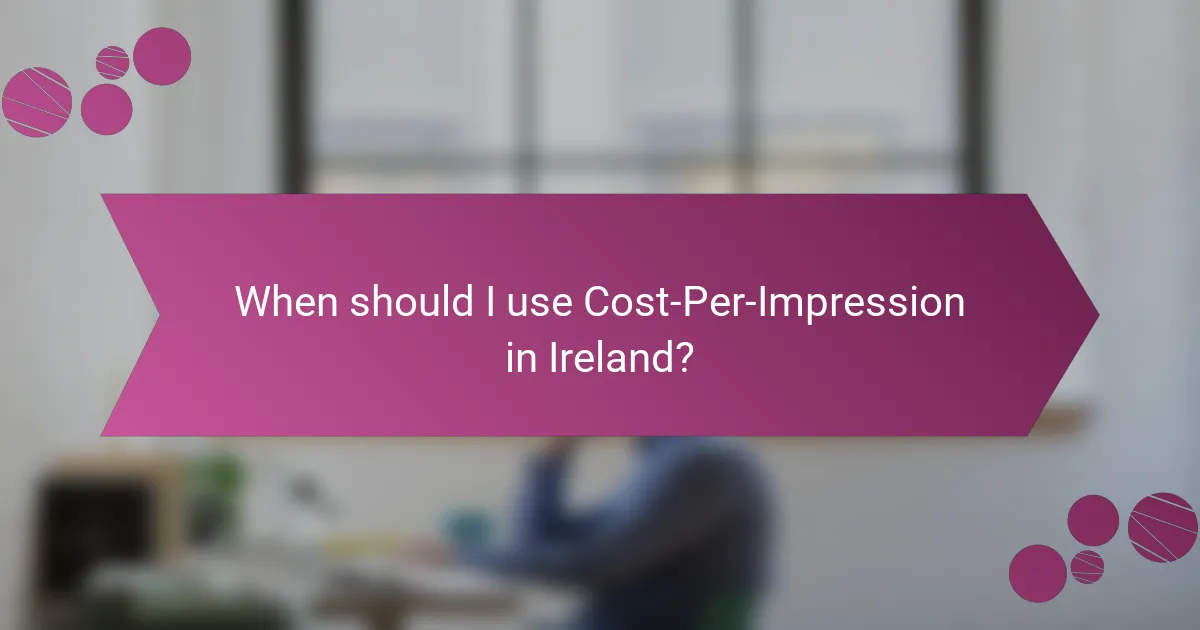
When should I use Cost-Per-Impression in Ireland?
Cost-Per-Impression (CPI) is ideal in Ireland when the goal is to maximize visibility rather than direct clicks. This model is particularly effective for campaigns focused on brand recognition and reaching a wide audience.
For brand awareness campaigns
Using Cost-Per-Impression for brand awareness campaigns allows advertisers to showcase their products or services to a large number of potential customers. Since the focus is on visibility, paying for impressions ensures that your brand is seen frequently, which can help build familiarity and trust over time.
For instance, if a company launches a new product, utilizing CPI can help ensure that the advertisement is displayed across various platforms, increasing the likelihood that consumers will recognize the brand when they encounter it later. This approach is particularly effective in crowded markets where standing out is crucial.
When reaching a broad audience
Cost-Per-Impression is beneficial when the aim is to reach a broad audience quickly. This model allows advertisers to cast a wide net, ensuring that their message is seen by many, regardless of whether the audience is likely to click immediately.
For example, a local business in Dublin might use CPI to promote a seasonal sale, targeting a large demographic across social media and display networks. This strategy can help generate buzz and attract foot traffic, even if not every impression leads to an immediate click or sale.

What are the key differences between Cost-Per-Click and Cost-Per-Impression?
Cost-Per-Click (CPC) and Cost-Per-Impression (CPM) are two distinct pricing models in online advertising. CPC charges advertisers only when a user clicks on their ad, while CPM charges based on the number of times an ad is displayed, regardless of user interaction.
Payment structure varies significantly
The payment structure for CPC and CPM is fundamentally different. With CPC, advertisers pay only when a potential customer engages with their ad, making it a performance-based model. In contrast, CPM requires payment for every thousand impressions, which means advertisers incur costs even if users do not click on their ads.
This difference can significantly impact budgeting and strategy. For campaigns focused on driving traffic and conversions, CPC may be more effective. However, for brand awareness campaigns where visibility is key, CPM could be the better choice.
Performance metrics differ
Performance metrics for CPC and CPM also diverge. CPC campaigns typically focus on click-through rates (CTR) and conversion rates, providing clear insights into user engagement and return on investment. Advertisers can easily track how many clicks lead to desired actions, such as purchases or sign-ups.
On the other hand, CPM campaigns emphasize impressions and reach. Metrics like cost per thousand impressions help advertisers understand how many users are exposed to their brand. This model is beneficial for measuring brand visibility but may not directly correlate with immediate sales or actions.

How to choose between Cost-Per-Click and Cost-Per-Impression?
Choosing between Cost-Per-Click (CPC) and Cost-Per-Impression (CPM) depends on your advertising objectives and target audience. CPC is ideal for driving traffic and conversions, while CPM is better for brand awareness and visibility.
Evaluate campaign goals
Start by clearly defining your campaign goals. If your primary aim is to generate leads or sales, CPC allows you to pay only when users click on your ad, making it a cost-effective choice for performance-driven campaigns. Conversely, if your focus is on maximizing exposure and building brand recognition, CPM can be more suitable as it charges based on impressions, regardless of user interaction.
Consider the nature of your product or service as well. For instance, e-commerce businesses often benefit from CPC since they can track direct conversions, while companies launching new products may prefer CPM to reach a broader audience quickly.
Consider target audience behavior
Understanding your target audience’s behavior is crucial in deciding between CPC and CPM. If your audience is likely to engage with ads and click through to your site, CPC may yield better returns. On the other hand, if your audience is more passive or if your goal is to increase brand visibility, CPM can effectively reach more users at a lower cost per impression.
Analyze past campaign performance data to guide your decision. If previous CPC campaigns resulted in high conversion rates, it may be wise to continue with that model. Alternatively, if brand recall and awareness metrics improved significantly with CPM, consider utilizing that approach for future campaigns.

What are the advantages of Cost-Per-Click?
Cost-Per-Click (CPC) advertising offers several advantages, particularly in driving targeted traffic and maximizing return on investment (ROI). Advertisers pay only when users click on their ads, making it a performance-based model that aligns costs with actual engagement.
Higher ROI potential
CPC campaigns can yield a higher ROI compared to other models, such as Cost-Per-Impression (CPM), because you only pay for actual clicks. This means your budget is spent on users who have shown interest in your product or service, increasing the likelihood of conversions.
For example, if you spend $100 on a CPC campaign and receive 50 clicks, your cost per click is $2. If those clicks lead to sales that exceed your initial investment, your ROI can be significantly higher than with impressions alone.
Better tracking of user engagement
CPC allows for more precise tracking of user engagement since you can measure how many users interacted with your ad. This data provides insights into which ads are performing well and which may need adjustments, enabling better optimization of your campaigns.
Using tools like Google Ads, you can analyze metrics such as click-through rates (CTR) and conversion rates. This information helps you refine your targeting and ad copy, ensuring that your advertising efforts are both effective and efficient.
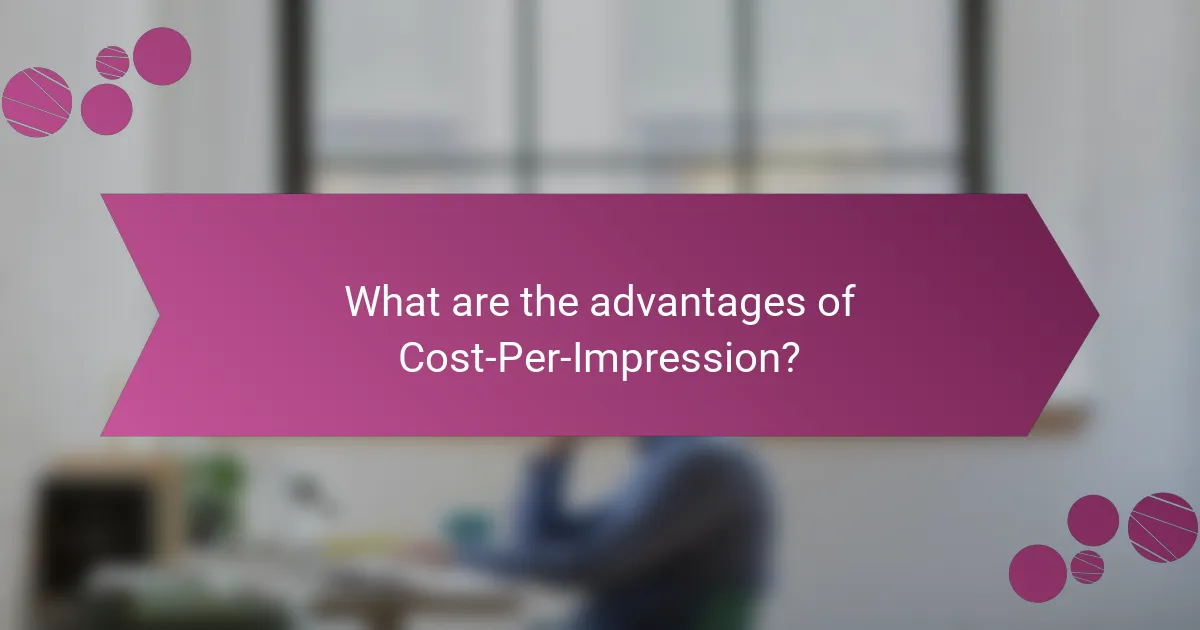
What are the advantages of Cost-Per-Impression?
Cost-Per-Impression (CPI) offers several advantages, particularly for brand awareness campaigns. It allows advertisers to pay for ad visibility rather than engagement, making it a strategic choice for reaching a larger audience.
Wider reach for brand campaigns
CPI is particularly effective for brand campaigns aiming to maximize exposure. By focusing on impressions, advertisers can place their ads in front of a broader audience, increasing the likelihood of brand recognition. This approach is beneficial for new products or services that need to establish visibility in a competitive market.
For instance, a company launching a new beverage might choose CPI to ensure their ads are seen by thousands of potential customers, even if not every viewer clicks on the ad. This can lead to higher brand recall over time.
Lower upfront costs for visibility
One of the key benefits of CPI is the lower upfront costs associated with gaining visibility. Advertisers can often secure ad placements at a lower price per impression compared to other models like Cost-Per-Click (CPC). This makes it easier for businesses with limited budgets to invest in advertising.
For example, a small business might allocate a budget of $500 for a CPI campaign, allowing them to generate thousands of impressions across various platforms. This strategy helps them maintain a presence without the risk of overspending on clicks that may not convert.

